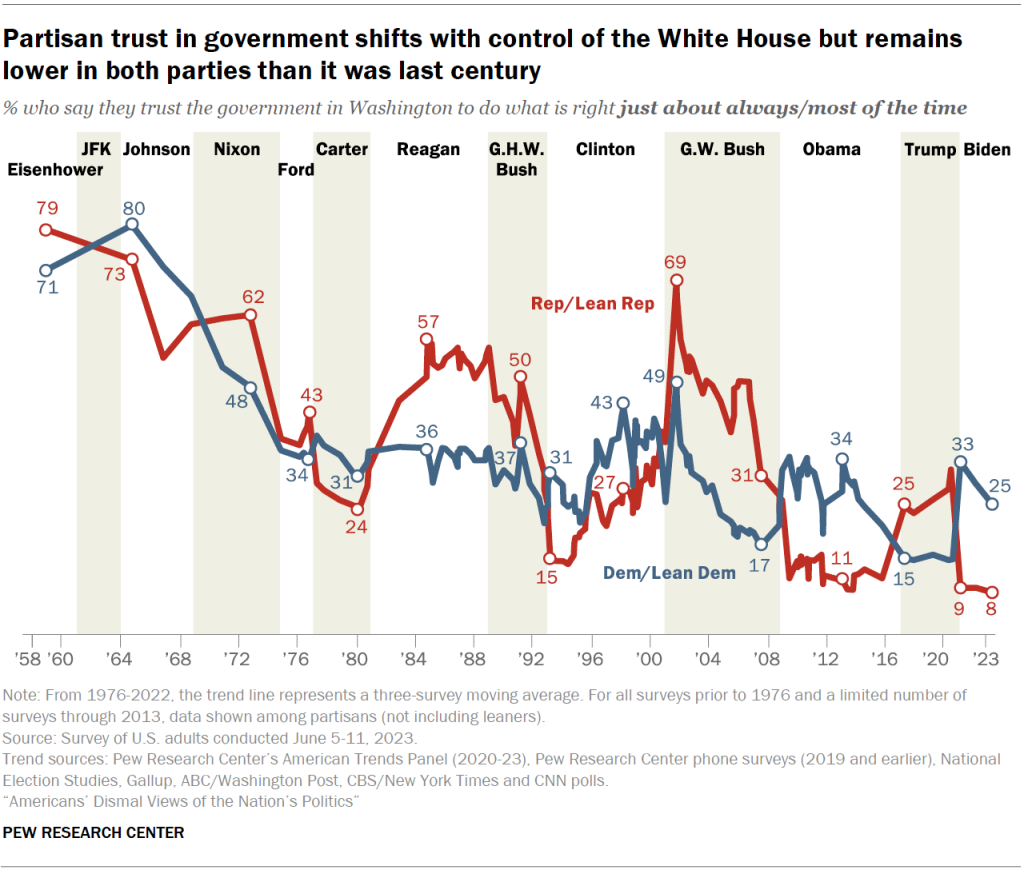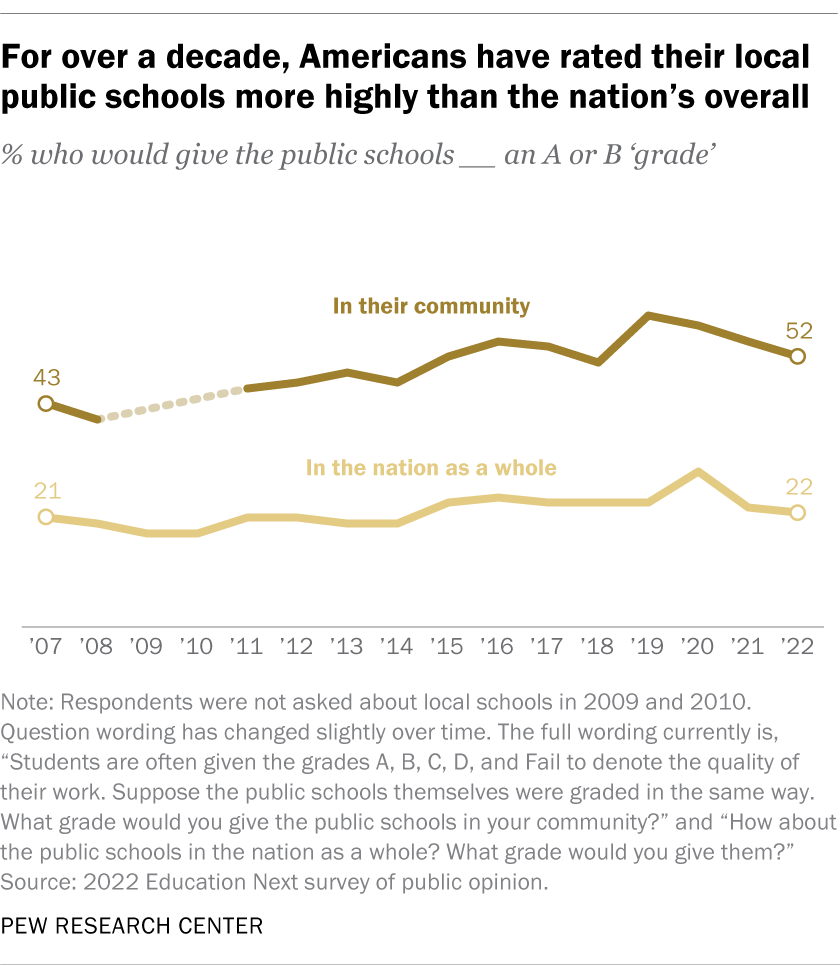Beyond Federal Chaos: Let States and Cities Govern
For long-term U.S. civic health, decentralize power.
Imagine if your child’s school had to rewrite its curriculum every few years based on who won the presidential election, or if a much-needed replacement to a local bridge was cancelled because of a national political fight.
This isn’t just hypothetical; Americans are experiencing whiplash from federal policy changes that reach deep into their daily lives, from healthcare to education to transportation. And right now we’re seeing an especially stark example that goes further into attacking the basic functioning of government.
The constant shifts aren’t just inefficient—they’re exhausting. They create anxiety for public servants, uncertainty for people who rely on services, and a sense that nothing is stable. Each new administration brings a flood of changes that ripple through every corner of American life. Could there be a better way?
The rude awakening
Centralizing power in the federal government is an extraordinary aggregator of risk, enabling a single administration to wreak havoc. Unfortunately, what’s happening right now—which is doing both short-term and long-term damage—is a particularly potent example of that.
Recent executive actions demonstrate how fragile and unpredictable centralized federal power can be. The cold reality is this: When the federal government is given an extraordinary amount of power across a wide range of subject areas, we put all of our eggs in one basket, as the saying goes.

If things go bad, they go really bad.
And unfortunately, trust in this federal basket is not in a good place.
The federal doom loop
We’re stuck in a doom loop of faith in the federal government. People’s trust in the federal government flips depending on the party in power, with Democrats more trusting when a Democrat is President and Republicans more trusting when a Republican is President.
While perhaps not a surprise by itself, what’s alarming is that over the course of the past 60 years, we’ve had an extraordinary long-term decline in overall trust:

Whichever party is out of power in Washington generally talks about how oppressive the federal government is and how important it is to respect state autonomy. Yet when that party wins a future election and takes office, they suddenly forget that passion and instead go all in on using a powerful federal government to push their agenda nationwide.
The good news: local and state government
There’s good news! People trust local and state government significantly more than the federal government—so despite the bleak federal picture (which we should try to reverse!), there are still units of government where the trust situation is much better.

And on issue after issue, people report feeling better about how things are going locally than nationally. For example, education:

Local and state decision-makers are also much more accessible, both in their physical and metaphorical proximity. I’ll say: I live in DC and have had multiple offices overlooking the White House, yet sometimes I think the federal government feels a world away from the DC government. I can’t imagine what it’s like for someone in Hawaii or Alaska.
This gives us an opportunity! To the extent possible, we can focus most domestic policy and services at the levels that people trust more and are more accessible: local and state.
De-risking + better governance
If concentrating certain power and services at the federal level presents a lot of risk, pushing or keeping these at the state and local level is an opportunity for “de-risking,” for two key reasons:
Reduced risk of simultaneous failure: If a federal agency is mismanaged, the consequences are national. But if that same service is dealt with at the state or local level, then even if the probability of mismanagement at any one time is the same, such instances would likely be spread out over time in different jurisdictions, dramatically reducing the likelihood of simultaneous nationwide failure.
Overall reduced risk of failure: State and local governments don’t operate in a vacuum—they watch each other’s successes and failures, so the problems in one place can then be a lesson for other places to avoid.
Under the infamous “Kansas experiment,” Kansas enacted massive tax cuts that were supposed to stimulate the economy but failed to do so—and led to devastating cuts to education and infrastructure. The governor became the least popular in the nation and eventually people got fed up and elected moderate Republicans to the legislature, who forced through tax increases to pay for increased government spending. (In 2018 voters elected a Democrat as governor, who was reelected in 2022 and is one of the 10 most popular governors in the country.)
Kansans learned a painful lesson, but so did the rest of the country—so states that might have considered such moves now know better. Aren’t you glad it was the Kansas experiment and not the U.S. experiment?

State and local governance offers even more benefits:
Experimentation, comparison, and inspiration: As there are 50 states and thousands of local governments, many approaches to policy and administration can be tried.
I’ve had the privilege to work with local officials from around the U.S. and world, and one of the most common pieces of feedback I’ve gotten when leading cohort learning opportunities is how much everyone appreciates being able to speak with and learn from fellow public servants in other cities: providing inspiration on things to try, tips on how to succeed, and lessons on what to avoid.
The diversity of approaches also allows for rigorous comparative research, and even casual comparisons like “The DMV worked better in the state that I used to live in; what can I do as a state legislator in my current state to make things here be more like over there?”
Choice and competition: People and businesses can often “vote with their feet,” choosing where to locate based on the policies and performance of state and local governments. This can help push decision-makers to do a good job and creates some friendly competition. It’s also an “escape valve” for people who can’t stand their state/local governments; federal control leaves you trapped unless you immigrate to another country. So concentrating power at lower levels of government helps “de-risk” at a personal level.
Customization: States and localities can customize policy and operations to the preferences and needs of specific communities, rather than one-size-fits-all nationwide approaches.
And thanks to the smaller pool of people involved, your personal energies can have a very visible impact in your local community:
Drawing clear lines
In his essay “Kludgeocracy in America,” Steven M. Teles wrote:
Even as the government expanded in the 1960s and '70s in areas ranging from the environment to education to health care, the federal government and the states continued to share the duties of governing in a complex web of responsibilities. While states and localities actually administer essentially all programs in these domains, the federal government is deeply involved as a funder, regulator, standard-setter, and evaluator. The result is the complicated “marble-cake federalism” structure that characterizes almost all domestic policy in the United States, making clear lines of responsibility hard to establish.

Focusing most domestic issues at the state and local level allows us to draw some clear lines:
Clarity: It makes it clearer to voters which level of government is responsible for what.
Focus: Elected officials can better focus their time and attention when fewer issues are on their plates. Federal leaders ought to be able to focus on issues that are federal by nature, like foreign affairs, defense, and interstate commerce, while state and local leaders would benefit from spending less time on federal compliance.
Accountability and responsibility: State and local leaders must be held accountable for the consequences of their decisions and encouraged to be fiscally responsible—rather than letting their mistakes be paid for by the rest out the country. Correspondingly, they should be allowed to take full advantage of the results of their good decisions.
Housing is a potent example of this. Certain specific regions of the country face a problem of high housing costs that’s driven by restrictive zoning, permitting, and construction rules. It’s not fair to then beg the federal government (meaning taxpayers nationwide) to subsidize housing programs in these places; instead, state and local leaders should have to take responsibility for fixing the problems that their own governments created.
Considerations and caveats
There are, of course, many key considerations and caveats—each of which could be its own post:
Which domains?: Precisely which issues to decentralize is a good question. In general, I would focus on education, local transportation, urban and rural development, social services, and local environmental affairs—but detailed analysis on each is critical. What we can’t do is look at individual issues and decide they’re all worth it to be federal but fail to look at the big picture of the resulting excessively powerful federal government. Siloed thinking is what got us into this risky mess of accumulated power.
Executive power: Many of the federal issues are particularly ones of executive overreach and a too-powerful presidency. Still, most would exist even without a powerful presidency.
Redistribution of money: Federal funding can be a way to level the playing field between wealthier and poorer states. In practice, some programs do that and others don’t, so there’s ample room to embrace this while slimming down federal involvement.
State vs. local: Which issues should be state vs. local depends on the size and geography of each state as well as the specific issues or functions in question. In practice, states vary drastically in how much autonomy they give local governments. (Frustratingly, state leaders sometimes rant about the evils of the central federal government while also denying their own localities autonomy.) Still, an imperfect split of state vs. local control is often an improvement over federal control.
Long-term benefits, short-term urgency
Concentrating too much domestic governance at the federal level creates systemic risks that we’re seeing play out right now. While the current chaos makes it difficult to think beyond the daily headlines, it’s precisely this tumult that makes rethinking our approach so urgent.
The path forward requires both immediate action and sustained commitment:
State and local leaders must step up to provide stability and essential services where federal functions falter
Federal lawmakers should work to deliberately and carefully devolve appropriate powers to state and local governments—instead of giving the federal government an ever-growing list of functions
Citizens should engage more deeply with their state and local governments, where their voice and vote carry greater weight
I plan to dive into specifics in the coming weeks. Make sure you’re subscribed to hear about my posts as soon as they come out!
I used to believe that a strong federal government was the best way to ensure consistent services and protections for all Americans. But years of watching policy whiplash, declining trust, and growing dysfunction have shown that we’ve concentrated too much risk in one place and provided an avenue for one president to wreak extraordinary havoc.
The good news is that we already have a better alternative: our state and local governments. They enjoy higher trust, greater accessibility, and the ability to innovate while learning from each other’s successes and failures.
Building more resilient governance isn’t just about weathering the storms of a few months or years—it’s about creating a system that can better serve Americans for generations to come. Let’s start now!



